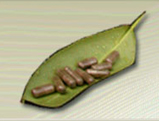 Loading... Please wait...
Loading... Please wait...Co2 Full Spectrum Holistic Herbs
ForsLean™: Ayurvedic herb Coleus forskohlii shows promise in enhancing lean body mass
Posted by Vladimir Badmaev, M.D., Ph.D., and Muhammed Majeed, Ph.D. on 9th Dec 2009
There are two important reasons to maintain or regain lean body mass. First, lean body mass plays a vital role in any successful weight training regimen. Second, there is growing awareness that lean body mass is proportionate to the overall health of an individual.
Lean body mass consists of muscles, vital organs, bone and bone marrow, connective tissue and body water. The percentage of lean body mass to fat not only determines the body’s aesthetic look, but more importantly, it determines a person’s physical fitness, health status and the risk of morbidity (disease) and premature mortality. A person can assess her body composition by calculating body mass index (BMI), attained by dividing body weight in kilograms by the square root of height in meters. The BMI norm is between 18 and 25 kg/m2. A value over 25 puts a person in the overweight category, and values greater than 30 correspond to various degrees of obesity.
Use of a standardized root extract from Coleus forskohlii (Fam. Labiatae) may help to increase lean body mass and optimize body composition. Coleus is a member of the mint family, is native to India and indigenous to its Ayurvedic medicine. Although traditionally used as a pickle or food spice, Coleus has gained prominence as the only plant source of diterpene forskolin. The compound forskolin is known to enhance adenylate cyclase, an enzyme that splits a high energy molecule of ATP to yield cyclic AMP. Nicknamed in literature as a “second messenger,” cyclic AMP facilitates the action of a “primary messenger” or various hormonal and bioactive substances in the body. The role of cyclic AMP is indispensable to many body functions. It causes a chain of biochemical events that paces body metabolism and food induced thermogenesis, and provides mechanisms for controlling body composition and lean body mass.
While the impact of lean body mass on health has yet to be fully understood, the health promoting value of increasing lean body mass can be appreciated indirectly due to the known benefits derived from physical exercise in building lean body mass and stamina. Consider that lean body mass correlates positively with the performance of an incremental treadmill exercise test and that the fat percentage in the abdomen is significantly less in elite athletes in comparison with non-exercising controls. Because abdominal fatty tissue is a significant risk factor for cardiovascular disease, exercise that results in increased lean body mass may have a positive impact on long-term cardiovascular risk and life span.
One rapidly growing segment of the U.S. population whose health is appreciably affected by imbalance in body composition is the geriatric group, especially those above 75 years of age. Aging itself diminishes lean body mass, but the elderly are also prone to develop conditions that either further deplete lean body mass and/or their bodies are deteriorated by an excess of body fat over the lean body mass. For example, occurrence of hypertension, adult onset diabetes mellitus and dyslipidemia increase with advancing age and obesity. These conditions may alter body composition with an increase of central obesity and decreased lean body mass.
It should be noted, however, that body composition and overall fitness are health predictors for the entire population regardless of age and gender. For example, one study examined the health benefits of leanness and the hazards of obesity in men while simultaneously considering fitness, as determined by maximal exercise testing. Interestingly, the unfit, lean men had a higher risk of all-cause and cardiovascular disease (CVD) mortality than men who were fit and obese. The impact of body composition and women’s health can be seen in a study in Norway. Total serum cholesterol and BMI were analyzed in 242 women compared to the general population during a mean follow-up of 12 years. Women whose total serum cholesterol values were elevated and/or who were obese had significantly higher chances of premature death in comparison to women with normal cholesterol levels and/or normal body weight.
Epidemiological studies indicate that the impact of body composition on our health starts early in life. The association between body mass and mortality in more than 100,000 U.S. women 30 to 55 years of age was evaluated. During 16 years of follow-up, 5 percent of overall deaths were documented–0.8 percent from cardiovascular disease, and 1.7 percent from other causes. The lowest mortality rate was observed among women who weighed at least 15 percent less than the U.S. average for women of similar age and among those whose weight had been stable since early adulthood. In a separate study, it was found that being overweight in adolescence predicted a broad range of adverse health effects that were independent of adult weight after 55 years of follow-up.
Increasing Lean Body Mass
The biochemical mechanism of maintaining or increasing lean body mass is related to the availability of cyclic AMP. By facilitating hormonal action, cyclic AMP may regulate the body’s thermogenic response to food, increase the body’s basic metabolic rate, and increase utilization of body fat (since thermogenesis is preferentially fueled by fatty acids derived from body fat and/or food). These events also correspond to the buildup of lean body mass. Based on the above rationale and mechanism of diterpene forskolin, Sabinsa Corporation has clinically tested its patented standardized extract of Coleus, ForsLean™, for its ability to increase lean body mass.
ForsLean is an extract of Coleus forskohlii root, standardized for 10 percent forskolin. In one study, ForsLean was tested in an open-field study with a population of six overweight women (BMI greater than 25). The tested formula was in the form of two-piece, hard shell capsules; each capsule contained 250 mg of the extract. The overweight, but otherwise healthy women, received the forskolin formula twice daily for eight weeks. Participants were instructed to take one capsule in the morning and one in the evening, half an hour before a meal. Each participant was asked to maintain her previous daily physical exercise and eating habits. In addition, physical activity was monitored based on a questionnaire before and during the trial. During the eight week trial, the mean values for body weight and fat content significantly decreased, whereas lean body mass was significantly increased as compared to the baseline. The regimen did not adversely affect the systolic/diastolic blood pressure nor the pulse rate; indeed, a trend was observed of lower systolic/diastolic pressure during the course of treatment.
Based on the results of this preliminary study, Sabinsa recently obtained a U.S. patent for ForsLean’s weight-loss mechanism. As mentioned previously, forskolin is known as a compound with versatile biological actions based on its ability to stimulate adenylate cyclase and cyclic AMP levels. Typically, an increase in cyclic AMP leads to subsequent activation of protein kinase. Protein kinase has been shown to activate the enzyme lipase, which disposes of triglycerides, known as building blocks of fatty tissue. The other factor relevant to the weight loss mechanism of forskolin involves its thyroid stimulating action, comparable in strength to thyrotropin or TSH. The thyroid stimulating action of forskolin may also contribute to the increase in the metabolic rate and thermogenesis. Forskolin may also be involved in regulating insulin secretion. Insulin, although well recognized for its metabolism of carbohydrates, is often overlooked as being involved with the metabolization of other macronutrients, i.e. fats and proteins, major contributors to body composition.
As advocated by the Centers for Disease Control, sensible, moderately intensive exercise for at least 30 minutes daily is the main method to maintain lean body mass. However, the combined effects of exercise and Coleus could contribute to and further optimize lean body mass. This approach could be especially useful to people who are disabled or elderly and may have a difficult time exercising due to physical limitations.
Because most weight loss regimens result in a drop in the metabolic rate and a decline in thyroid function, use of Coleus as an adjunct to exercise could be particularly relevant. A decreased metabolic rate and thyroid function often lead to the loss of lean body mass, which limits the health benefits of trimming the waistline. This undesired and often detrimental effect on lean body mass also illustrates the limitations of low calorie diets in weight loss regimens.
One study found that formerly obese subjects had a 3 to 5 percent lower resting metabolic rate than control subjects. The occurrence of a low resting metabolic rate is likely to contribute to the high rate of weight regain in formerly obese persons. The very nature of many weight loss regimens may limit the beneficial outcome of the weight loss therapy. In another study, 20 middle-aged subjects were randomly assigned to a standard treatment (appetite suppressant) plus diet or a resistance exercise plus diet. Both groups consumed a very low calorie diet (800 kcal/day liquid formula) for 12 weeks. The standard treatment plus diet group lost a significant amount of lean body mass, whereas no decrease in lean body mass was observed in the group with resistance exercise and diet. In addition, the diet plus exercise group had an increase in their resting metabolic rate, while the resting metabolic rate decreased in the standard treatment group.
It should be emphasized that healthy functioning of the body depends not so much on a lower fat content, but rather on obtaining a higher percentage of lean body mass. Straight dieting often results in a loss of not only the fat but also lean body mass. And as previously pointed out, loss of lean body mass offsets any benefits derived from the reduction of body weight, and can potentially increase one’s chances for diabetes, cardiovascular disease due to poor metabolic activity.
Sabinsa’s preliminary clinical study with Coleus showed that 25 mg of forskolin twice a day can improve overall body weight by increasing lean body mass and by decreasing weight from body fat. Thus, the use of forskolin is about body composition management rather than weight loss. In view of this finding, forskolin can potentially benefit not only overweight people but also those individuals who are active in training or body building and are looking to increase their lean body mass to body fat ratio. Supplementation with forskolin can help in gaining health for those already engaged in a healthy active lifestyle and assists in regaining health for those who are less active and need help. Thus, forskolin supplementation can potentially benefit a large group of people to help restore health by restoring a healthy body composition.
References available on request; call (480) 990-1101 ext. 1018.
Vladimir Badmaev, M.D., Ph.D., was trained in clinical and anatomical pathology at Kings County Hospital and Downstate Medical Center, both in New York. His Ph.D. is in the field of Immunopharmacology. Muhammaed Majeed holds a Ph.D. in Industrial Pharmacy from St. John’s University in New York.















